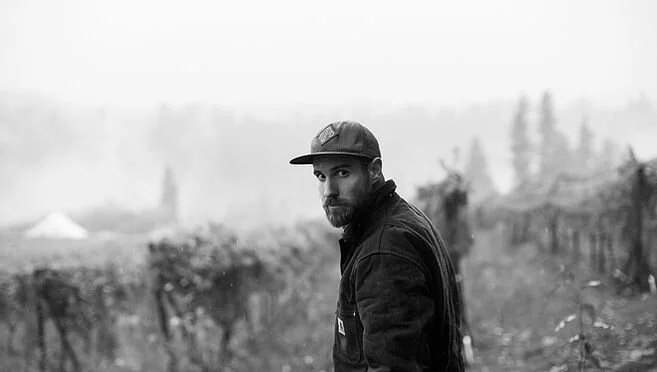WINE MINUS Ø - December 2020: Wine is Food
Gatherings Christchurch, NZ
December is a magical month in the cellar. The space that only weeks ago was tightly packed with fermenters, pumps, tanks, and hoses is suddenly tidy and quiet. Fresh, new wines are tucked away in barrel - full of hope and possibility - slowly crackling through malolactic fermentation. The all encompassing effort and interminable hours of harvest have suddenly given way to the slow pace of winter work - topping, planning, and monitoring - and with the forward charge abruptly halted, there is a unique opportunity for reflection.
And so it happened that on a recent afternoon, while carefully dotting chromatography paper, I began to wonder about natural wine. Call it a search for meaning or a philosophical crisis, as a producer committed to low intervention winemaking, I paused to ask myself, why does it matter? Why do we care?
Thankfully, without much difficulty, I quickly thought of three meaningful reasons why natural wine is important and is growing in significance. In this month’s Midnight Correspondence we explore one of them, and perhaps in the coming months we will dive-in to the other two. Since this is more of a brainstorm than an exhaustive list, we are opening the comment section below and welcome your thoughts in answer to the question: Why natural wine?
To get us started:
Wine is Food
Back in 2017 Eric Asimov wrote an article for The New York Times titled "Want to Pick Better Bottles? Repeat After Me: Wine is Food.” In it, he not only addressed the age-old concept that wine is an integral part of a meal, but also the idea that, as something that we consume, we should be equally attentive to the constituents of our wine as to our meat, dairy, or vegetables. If wine is food, then it makes sense to be concerned about chemicals sprayed in the vineyard or added in the cellar. Asimov asserts that “when it comes to wine, many who care deeply about their food are still drinking the equivalent of the square tomato.” He argues for greater transparency and more comprehensive wine labeling, but also notes that simply by re-framing our perspective on wine, we could effectively steer the industry away from “processed wines” in the same way that, with greater awareness, people have turned to farmer’s markets and organic groceries for their staple foods.
Wine is Agriculture
Worldwide, vineyards cover millions of acres dotting hillsides across Europe as well as Chile, South Africa, Australia… you get the point. As perennial plants that can grow well on soils less suitable for food production, vineyards can either be part of the problem or the solution. They can either continue to deplete the land or they can create spaces for biodiversity and contribute to carbon draw down. A 2016 study by the Sonoma Research Conservation District spanning only 2.5 years found 13% higher total carbon in no-till vineyard plots vs. tilled plots. The finding suggests that no-till vineyard management leads to more organic matter in the soil and ultimately better soil health. How we treat our soil has wide-ranging and increasingly significant impacts, but with the developments of industrial agriculture, the question of tilling is only one of many crucial choices that modern winegrowers and other farmers face. If wine is agriculture, then it makes sense to seek out farmers who are invested in regenerative practices and sustainable farming.
Wine is Art
Ah, here the intangible wind in the trees.
In a cheeky article addressing the old “science or art” question Jancis Robinson writes:
“Wine is often described as an expression of terroir, and its makers as mere conduits for mother nature, allowing the grapes to tell their own story. But that’s disingenuous at best. Aaron Lee Tasjan doesn’t claim to be channelling the intrinsic notes from his guitar. Making music, like making wine, involves making decisions; matters of opinion. It is these choices which determine what results in the glass, from what to plant to when to pick to which oak to use. What are these choices if not artistic?
While natural winemakers, in particular, often tip their hats and claim terroir, wine-making remains a craft and wine-drinking, at its best, evokes emotion. If wine is art, then it makes sense to look for the truest and most genuine expressions.
Since we could all use a little extra comfort in these darkest days of winter, this month, we’re going to meditate on wine as food. The two wines we’ve selected are grown without pesticides, herbicides, or chemicals and are made without any manipulation in the cellar. They are, as arguably wine should be, simply grapes, fermented, aged, and bottled.
Graham Markel of Buona Notte Wines
We asked our friend - and a rising star in the natural wine world - Graham Markel of Buona Notte to create some recipes to accompany these bottles. Graham grew up traveling Italy with his mom who taught cooking classes there, and he has both a deep connection to and a natural instinct for food and flavor. To explore the wines that Graham crafts in the Columbia Gorge, click here.
MIDNIGHT CORRESPONDENCE SELECTIONS, DECEMBER 2020
1. Agnes & Renee Mosse Savennieres Arena 2016
EAT WITH: Galette Saucisse - Delicious French Street Food
Crêpes/Pancakes
80 g buckwheat flour
80 g all-purpose flour
1/2 tsp salt
2 eggs
225 ml milk
30 ml water
Filling
5 pork sausages or any of your favorite sausage
3 onions
1/2 tbsp sugar
salt to taste
pepper to taste
1/2 tbsp fennel seeds
optional Other: butter, mustard Dijon
Crêpes/Pancakes
Put all the ingredients into a bowl and whisk together until combined. Let rest for an hour.
Heat up a nonstick frying pan, put a little bit of butter onto it. Cover the pan with the melted butter and ladle in just enough of the batter to cover the pan. While pouring in the batter, tilt the pan to make sure the batter spreads easily over the bottom of the pan. These pancakes should be as thin as possible so don't overfill your pan with batter.
When the batter of the pancake is 'dry' on top you can flip the pancake and let bake for another 30 seconds to a minute before transferring the pancake to a plate.
Repeat the process till you're out of batter. Stack the pancakes on top of each other as you're baking. Set the pancakes aside while you work on the filling.
Filling
Chop the top and the root of the onions off. Cut the onions in half and remove the skin. Slice the onions in thin slices.
In a casserole, melt some butter on a medium-high heat. Put in the sliced onions and stir to coat all the onions with butter. Slowly let the onions glaze, turn translucent and eventually turn brown and caramelize. When the onions start to caramelize and turn brown, add the sugar. Season with salt and pepper to taste. Once the onions are caramelized, turn off the heat and transfer the onions to a bowl and set aside.
In the same casserole add a little butter and melt over a medium heat, add the fennel seeds and the sausages. Cook the sausages turning them every few minutes till they're nice golden brown on all sides. Keep turning them for roughly 12 minutes. each sausage is different so yours might take a little longer or a little less time to cook Make sure they're really hot and thoroughly cooked through and that no pink remains.
When the sausages are done, turn off the heat.
Assembling
Take your pancake and spread some mustard over the pancake (or alternatively you can put some on the sausage itself).
In the middle of the pancake put your hot sausage and put some caramelized onions on top.
Wrap the pancake around the filling. Pull up the bottom over the filling first and wrap the sides around it to ensure nothing falls out at the bottom of the sausage. Serve immediately.
2. Frank Cornelissen IGP Terre Siciliane Munjebel 2018
EAT WITH: Pasta con le Sarde - Sweet and savory pasta with some of the classic ingredients that make Sicily so amazing.
YIELD: Serves 4
TIME: 1 hour
INGREDIENTS
½ cup currants
¼ teaspoon red-pepper flakes
½ cup dry white wine
1 tablespoon butter
½ cup unseasoned dry bread crumbs
½ cup plus 6 tablespoons extra-virgin olive oil
1 medium onion, finely chopped
2 small cloves garlic, minced
1 pound fennel, bulb finely chopped, fronds chopped and reserved
1 tablespoon fennel seeds, crushed
Salt
2 pounds fresh sardines (trimmed and deboned, yielding 1 1/4 pounds) or 1 pound canned
1 pound bucatini pasta
½ cup pine nuts, toasted
¼ cup capers, rinsed
Freshly ground black pepper
PREPARATION
Bring a large pot of water to a boil. Combine the currants, red-pepper flakes and wine in a bowl; set aside. In a small sauté pan, melt the butter. Add the bread crumbs and cook, stirring, until golden brown. Transfer to a bowl, stir in 2 tablespoons of the olive oil and set aside.
In a heavy skillet, heat 1/2 cup olive oil over medium-low heat. When hot, add the onion, garlic, fennel bulb and fennel seeds. Season with salt. Cook, stirring occasionally, until the fennel is tender, about 25 minutes.
Add the wine mixture and the sardines, breaking them into pieces with a fork. Bring to a boil and gently simmer for 10 minutes.
Add enough salt to the boiling water so that it tastes salty. Boil the bucatini until al dente, 6 to 8 minutes; strain. Return the pasta to the pasta pot and set over low heat. Fold in the fennel-sardine mixture. Toss in the remaining 4 tablespoons olive oil. Add 3/4 of the fennel fronds, the pine nuts, the capers and a quarter of the bread crumbs. Season to taste with salt and pepper.
Divide pasta among plates and sprinkle the remaining bread crumbs and fennel fronds over each. Serve immediately.
SKINNY DIPPING IN THE WATERTOWER SELECTIONS, DECEMBER 2020
Domaine Matassa Vin de France Coume de l'Olla Rouge 2019
La Possa Vino Rosso da Tavola U Neigru
Click on each wine for more detail.


